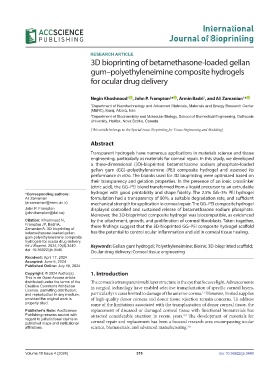Page 327 - IJB-10-4
P. 327
International
Journal of Bioprinting
RESEARCH ARTICLE
3D bioprinting of betamethasone-loaded gellan
gum–polyethyleneimine composite hydrogels
for ocular drug delivery
Negin Khoshnood 1 id , John P. Frampton * , Armin Badri , and Ali Zamanian *
1
1 id
2 id
1 Department of Nanotechnology and Advanced Materials, Materials and Energy Research Center
(MERC), Karaj, Alborz, Iran
2 Department of Biochemistry and Molecular Biology, School of Biomedical Engineering, Dalhousie
University, Halifax, Nova Scotia, Canada
(This article belongs to the Special Issue: Bioprinting for Tissue Engineering and Modeling)
Abstract
Transparent hydrogels have numerous applications in materials science and tissue
engineering, particularly as materials for corneal repair. In this study, we developed
a three-dimensional (3D)-bioprinted betamethasone sodium phosphate-loaded
gellan gum (GG)–polyethyleneimine (PEI) composite hydrogel and assessed its
performance in vitro. The bioinks used for 3D bioprinting were optimized based on
their transparency and gelation properties. In the presence of an ionic crosslinker
(citric acid), the GG–PEI blend transformed from a liquid precursor to an extrudable
*Corresponding authors: hydrogel with good printability and shape fidelity. The 2.5% GG–3% PEI hydrogel
Ali Zamanian formulation had a transparency of 80%, a suitable degradation rate, and sufficient
(a-zamanian@merc.ac.ir) mechanical strength for application in corneal repair. The GG–PEI composite hydrogel
John P. Frampton displayed controlled and sustained release of betamethasone sodium phosphate.
(john.frampton@dal.ca)
Moreover, the 3D-bioprinted composite hydrogel was biocompatible, as evidenced
Citation: Khoshnood N, by the attachment, growth, and proliferation of corneal fibroblasts. Taken together,
Frampton JP, BadriA, these findings suggest that the 3D-bioprinted GG–PEI composite hydrogel scaffold
ZamanianA. 3D bioprinting of
betamethasone-loaded gellan has the potential to control ocular inflammation and aid in corneal tissue healing.
gum-polyethyleneimine composite
hydrogels for ocular drug delivery.
Int J Bioprint. 2024;10(4):3440. Keywords: Gellan gum hydrogel; Polyethyleneimine; Bioink; 3D-bioprinted scaffold;
doi: 10.36922/ijb.3440 Ocular drug delivery; Corneal tissue engineering
Received: April 17, 2024
Accepted: June 6, 2024
Published Online: July 16, 2024
Copyright: © 2024 Author(s). 1. Introduction
This is an Open Access article
distributed under the terms of the The cornea is a transparent multilayer structure in the eye that focuses light. Advancements
Creative Commons Attribution in surgical technology have enabled selective transplantation of specific corneal layers,
License, permitting distribution, 1,2
and reproduction in any medium, particularly in cases limited to damage of the anterior cornea. However, limited supplies
provided the original work is of high-quality donor corneas and donor tissue rejection remain concerns. To address
properly cited. some of the limitations associated with the transplantation of donor corneal tissue, the
Publisher’s Note: AccScience replacement of diseased or damaged corneal tissue with functional biomaterials has
Publishing remains neutral with attracted considerable attention in recent years. The development of materials for
3,4
regard to jurisdictional claims in
published maps and institutional corneal repair and replacement has been a focused research area encompassing ocular
affiliations. science, biomaterials, and advanced manufacturing. 5,6
Volume 10 Issue 4 (2024) 319 doi: 10.36922/ijb.3440

